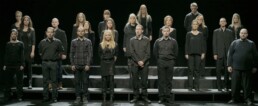ANA ADAMOVIĆ (1974)
Madeleines
one-channel video, colour, sound
3’42”
edition: 1/5
2004
My Country Is the Most Beautiful of All
three-channel video installation
2’51”
2011–2013
Madeleines
one-channel video, colour, sound
3’42”
edition: 1/5
2004
“With the series Madeleines, the artist started exploring into the nature of human memory. Old family photographs, recorded by an eight-millimetre camera, form the basis of the work. The video works were created through photo manipulations – they act as a window into the subconscious, with their aesthetics and the atmosphere they induce. The boundary between a true event from the past and a memory created through the image is being deleted.
Milica Pekić, from the catalogue of the 51st October Salon
Ana Adamović participated in the 47th October Salon Art, Life and Confusion, with Postcards from Imaginary Places, and in the 49th October Salon with the work Revealing. Her video Canzona was awarded at the 51st October Salon, at which the work Madeleines was also exhibited. At the 55th October Salon, she presented the three-channel video installation The Choir.
The mechanism of memory has not yet been fully explained. Numerous and complex clues lead us to our personal memories. The works from the Madeleine Series, begun in 2004, aim to explore images that are or might be memory triggers. With photographs and video works, the author opens up possibilities for different interpretations of individual and collective images of the past.
“The title of the series – Madeleines – comes from Proust’s novel In Search of Lost Time. Madeleine is a small cake that, dipped in tea, becomes a trigger for the writer’s memory. Thanks to madeleine, the author started his search of lost time.”
Ana Adamović
© Cultural Centre of Belgrade, October Salon Collection and the artist
Gift Contract: III-5-220/14.8.2014.
Inventory No. 1332
Photo: still from the video work
My Country Is the Most Beautiful of All
three-channel video installation
2’51”
2011–2013
Kolibri was the most famous children’s choir in the former Yugoslavia. It was founded by Milica Manojlović, in 1963, as the children’s choir of the Radio-Television Belgrade. (Interestingly, in the same year Yugoslavia changed its name from the Federal People’s Republic of Yugoslavia to the Socialist Federal Republic of Yugoslavia, the name it would hold until its break-up). During the 1970s and 1980s, Kolibri sang both children’s and patriotic songs, most often written especially for them. From the mid-1970s, the song My Country Is the Most Beautiful of All became part of their standard repertoire and the choir sang it on various occasions for almost three decades.
“In April 1987, the choir had a concert at the Belgrade Kolarac Concert Hall. The former choir members who were present in the audience joined the choir on the stage to sing the last two songs together. One of these songs was My Country Is the Most Beautiful of All.
Four years after the concert, a war in the Former Yugoslavia broke out. The violent disintegration of the country finally ended with the NATO intervention in the then FRY in 1999. During this war, the largest conflict in Europe since World War II, more than 130,000 people were killed.
Exactly 24 years after the concert at Kolarac and 20 years after the war began in the Former Yugoslavia, some of the former members of the Kolibri Choir reunited in the same city but in a completely different country – to sing the song My Country Is the Most Beautiful of All once again.”
Ana Adamović
My Country Is the Most Beautiful of All– Svetislav Vuković
When springtime paints the landscape / in crimson, green and gold, / when leaves of crops are swaying and on the whole, / my country is the most beautiful of all. //I love it when its skies/ with colours of a rainbow glow, / I love it when it is hidden / under a blanket of snow. / On the whole, / my country is the most beautiful of all. // The land of glory and heroes / I keep it in my soul, /I’m proud of it always. / My country is the most beautiful of all.
© Cultural Centre of Belgrade, October Salon Collection and the artist
Purchase Contract: III-5-155/25.5.2016.
Inventory No. 1427
Photo: still from the video installation
Selected Bibliography:
47th October Salon, Art, Life and Confusion. Cultural Centre of Belgrade, 2006
49th October Salon, Artist – Citizen. Cultural Centre of Belgrade, 2008
51st October Salon, The Night Pleases Us. Cultural Centre of Belgrade, 2010
55th October Salon, Disappearing Things. Cultural Centre of Belgrade, 2014
Two Choirs, Ana Adamović, Feb. 28 – Mar. 23, 2014, Salon of the Museum of Contemporary Art, Belgrade, 2017
ABOUT THE AUTHOR:
Ana Adamović (1974, Belgrade, Serbia) deals with issues of identity and memory, both personal and collective, working on the long-term photo and video projects. Since 1999 she has exhibited in the country and abroad. She graduated in world literature from the Faculty of Philology in Belgrade, studied photography at the Boston Art Institute and obtained a PhD from the Academy of Fine Arts in Vienna. She is the founder of Kiosk, a platform for contemporary art. Lives and works in Belgrade. More information at http://anaadamovic.com/

